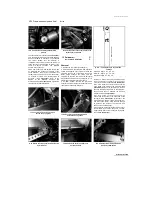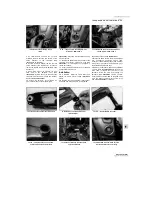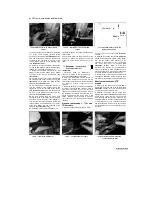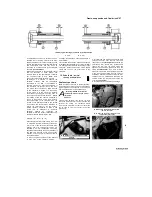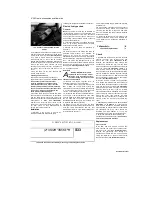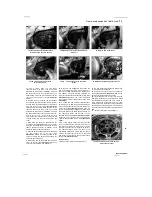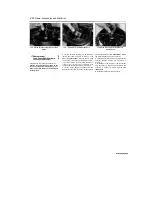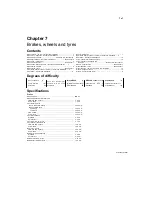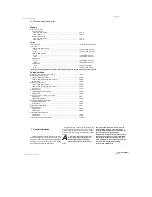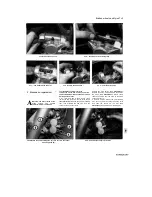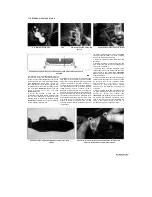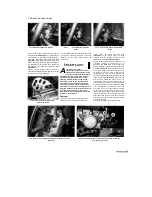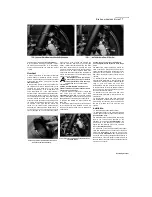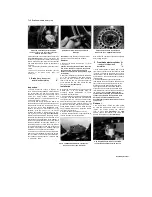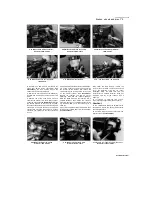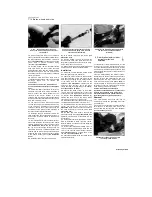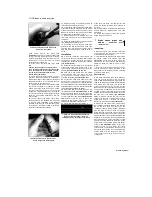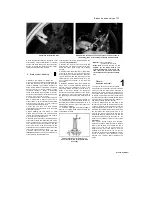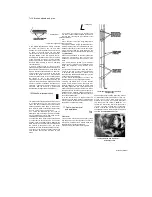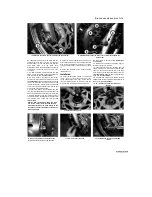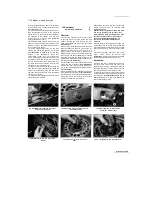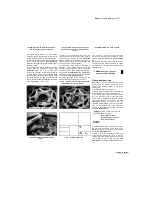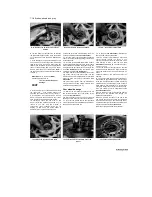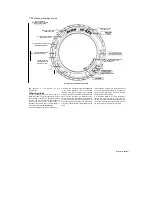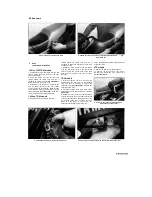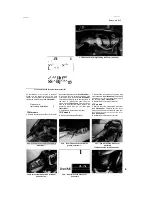
7»8 Brakes, wheels and tyres
4.2 Set up a dial gauge with the probe
contacting the brake disc, then rotate the
wheel to check for runout
4.3 Using a micrometer to measure disc
thickness
4.5 Unscrew the bolts (arrowed) and
remove the disc - TDM rear disc shown
holding the hose nut to prevent the hose twisting
(see illustration 3.2b).
Do not overtighten the
locknut. Top up the master cylinder reservoir with
DOT 4 brake fluid (see
Daily (pre-ride) checks)
and bleed the hydraulic system as described in
Section 8.
18 On XTZ models, install the rear brake caliper
shield.
19 Check for leaks and thoroughly test the
operation of the brake before riding the
motorcycle.
4
Brake
discs - inspection,
^
removal and installation
#*
Inspection
1 Visually inspect the surface of the disc for
score marks and other damage. Light scratches
are normal after use and won't affect brake
operation, but deep grooves and heavy score
marks will reduce braking efficiency and
accelerate pad wear. If a disc is badly grooved it
must be machined or renewed.
2 To check disc runout, position the bike on an
auxiliary stand and support it so that the wheel is
raised off the ground. On XTZ models, remove
the front disc covers
(see illustration 11.5).
Mount a dial gauge on a fork slider or on the
swingarm, with the plunger on the gauge
touching the surface of the disc about 10 mm
(1/2 in) from the outer edge
(see illustration).
Rotate the wheel and watch the gauge needle,
comparing the reading with the limit listed in the
Specifications at the beginning of the Chapter. If
the runout is greater than the service limit, check
the wheel bearings for play (see Chapter 1). If
the bearings are worn, renew them (see Section
13) and repeat this check. If the disc runout is still
excessive, it will have to be renewed, although
machining by an engineer may be possible.
3 The disc must not be machined or allowed to
wear down to a thickness less than the service
limit as listed in this Chapter's Specifications.
The thickness of the disc can be checked with
a micrometer
(see
illustration).
If the thickness of the disc is less
than the service limit, it must be renewed.
Removal
4 Remove the wheel (see Section 11 (front)
or 12 (rear)).
Caution: Do not lay the wheel down and allow
it to rest on the disc or sprocket -they could
become warped. Set the wheel on wood
blocks so the disc doesn't support the weight
of the wheel.
5 Mark the relationship of the disc to the wheel,
so it can be installed in the same position.
Unscrew the disc retaining bolts, loosening
them a little at a time in a criss-cross pattern to
avoid distorting the disc, then remove the disc
from the wheel
(see illustration).
Installation
6
Install the disc on the wheel, making sure the
marked side is on the outside. Align the
previously
applied
matchmarks
(if
you're
reinstalling the original disc).
7 Apply a suitable non-permanent thread locking
compound to the disc bolts, then install the bolts
and tighten them in a criss-cross pattern evenly
and progressively to the torque setting specified
at the beginning of the Chapter. Clean off all
grease from the brake disc(s) using acetone or
brake system cleaner. If a new brake disc has
been installed, remove any protective coating
from its working surfaces.
8 Install the wheel (see Section 11 or 12).
9 Operate the brake lever or pedal several times
to bring the pads into contact with the
disc. Check the operation of the brakes carefully
before riding the bike.
5 Front brake master cylinder
&>
- removal, overhaul and
S
installation
^
Q
1 If the master cylinder is leaking fluid, or if the
lever does not produce a firm feel when the brake
is applied, and bleeding the brakes does not help
(see Section 8), and the hydraulic hoses are all in
good condition, then master cylinder overhaul is
recommended.
2 Before disassembling the master cylinder,
read through the entire procedure and make sure
that you obtain a new piston/seal kit. Also, you
will need some new DOT 4 brake fluid, some
clean rags and internal circlip pliers.
Note:
To
prevent damage to the paint from spilled brake
fluid, always cover the fuel tank when working on
the master cylinder.
Caution: Disassembly,
overhaul and reassembly of the brake master
cylinder must be done in a spotlessly clean
work area to avoid contamination and
possible failure of the brake hydraulic system
components.
Removal
3 On XTZ models, remove the hand guard.
On TDM and XTZ models, loosen, but do not
remove, the screws holding the reservoir
cover in place
(see illustration).
On
TRX
models, remove the reservoir cap clamp and
partially unscrew the cap
(see illustration).
Scaned by Stalker
5.3a On TDM and XTZ models, slacken the
reservoir cover screws (arrowed)
5.3b On TRX models, remove the clamp
(arrowed) and partially unscrew the cap

